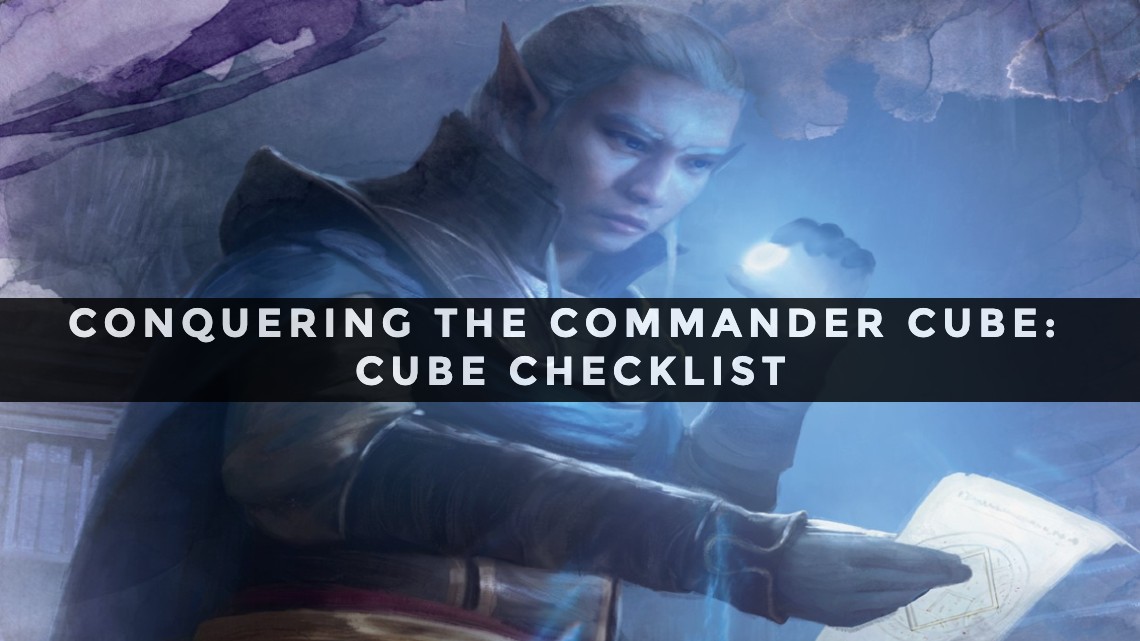Conquering the Commander Cube: Cube Checklist

Arcane Investigator | Illustrated by Bram Sels
Greetings, Commander players! I'm pleased to announce that we at the Commander's Herald have decided to extend "Conquering the Commander Cube" into a series. For those who haven't read the original article I wrote, I recommend reading it first.
For context, the original "Conquering the Commander Cube" article discussed some of the key considerations to keep in mind when constructing a Commander cube. If you aren't sure what a Commander cube is, I highly recommend reading the original article linked above. I also recommend this Draftism article.
In this series, we will be discussing important topics about designing cubes and making them fun to both build and play. In this article, we will be starting with the basics and covering everything that you need to build a Commander cube.
Let's jump in and look at Commander cube essentials!
Cards! Cards! Cards!
This may sound like an obvious one, but choosing the right cards is a challenging task that will undoubtedly take up the lion's share of one's time in building a cube. I will be covering the decision-making process for choosing cards for your cube in subsequent articles, but for today, I will pose the question of how many cards you want to include in your cube. As I mentioned in my original article, there are four generally accepted cube sizes, and they are constituted as follows:
- Small Cube = 360 cards
- Medium Cube = 540 cards
- Large Cube = 720 cards
- X-Large Cube = 900+ cards
If you are building your first cube, I recommend building a small- or medium-sized cube, as balancing and designing a cube generally proves to be more challenging than many realize, especially for one's first cube.
Card List
You will want to have a list of every card included in your cube, as something is bound to happen to your cards across the lifespan of your cube and you'll want to have a way to check your inventory to see which cards might be missing or misplaced.
A card list will also make it easier to go back and modify or rebalance your cube. I would recommend compiling a card list in advance of building your cube, as it allows you to balance your cube in advance and take inventory of which cards you own and which ones you still need to purchase for your cube.
The Cube
Obviously, you will need something to store all of your cube cards in. It's worth noting that your card storage for your cube doesn't necessarily need to be an actual cube. Anything that can fit all of your cards will work as a cube; you just want to make sure that whatever storage device you use will keep your cards safe and secure.
It's worth noting that Ultra Pro released a cube product that was designed exactly for that purpose, but like most Ultra Pro products, that product had a limited release and now they are hard to come by.
There are also many talented creators on Etsy who have created custom Commander cubes, and I recommend taking a look at the wide selection of cubes available.
Card Sleeves
This one is another given, but do remember that you will need to make sure that all of the sleeves are the exact same color and make, for even slight color or texture variations will allow players to delineate cards. I recommend writing down the exact name of the brand, color, and make of sleeves that you plan on using so that you can be sure that you are buying the correct sleeves for your cube.
Pack Boxes
Another thing that you will need are "packs," or boxes to put cards in so that players can draft packs in a similar fashion to other formats. In other formats, such as booster drafts, cards are simply stored in official packs until they are ready to be opened and drafted, but for a Commander cube, it's up to the owner of the cube to provide preconstructed packs in preparation for the cube draft.
Just like cubes, you will find a variety of official and independently made draft boxes available for sale online.
Tokens, Counters, and Dice
It's worth providing an extra pool of tokens, counters, and dice for other players to use during a cube draft, as there is a common assumption for players that if someone else is bringing a cube to a draft, then they don't need to bring anything to the event.
While some vigilant players will bring their own accessories and extra pieces to nearly every MTG gathering that they attend, not every player will remember those things, so it's a common courtesy to bring auxiliary pieces that other players might need.
Final Thoughts
The things mentioned above are the essentials that you need to get started with your cube. As you playtest your cube and grow your collection, your cube will inevitably change, so make sure to keep an up-to-date inventory of all the cards in your cube. I recommend using a deckbuilding platform, like Moxfield or Archidekt, to catalogue your cube decklist. Just as Disney said that Disneyland will never truly be complete, so too will your cube never be complete. You will make changes as you refine your cube and as new cards are released, and that's okay! It's part of the process, and hopefully it's one that you will enjoy.
I look forward to exploring more aspects of Commander cubes in the coming weeks, so if this is a topic that interests you, be on the lookout for subsequent entries of Conquering the Commander Cube. Happy gathering, players!